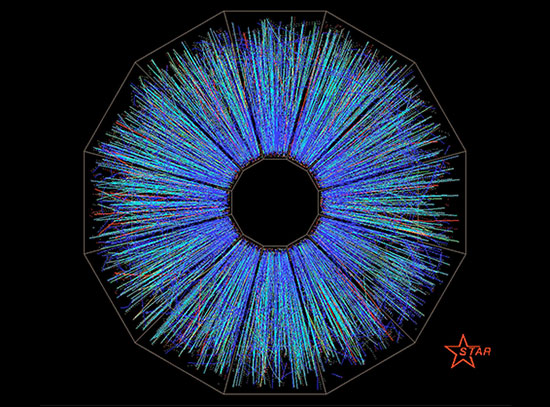Brookhaven Lab Releases 2005 Site Environmental Report
October 17, 2006

UPTON, NY - The U.S. Department of Energy's Brookhaven National Laboratory has issued its 2005 Site Environmental Report. Report highlights include significant progress on the environmental cleanup of the site, continued expansion of pollution prevention initiatives, and reduced environmental effluents and emissions. The document can be found on the internet at http://www.bnl.gov/ewms/ser/.
The Site Environmental Report is prepared annually to summarize Brookhaven's environmental data; environmental management performance; compliance with applicable DOE, federal, state, and local regulations; and restoration and monitoring programs. It also documents the steady progress toward cleaning up the site and fully integrating environmental stewardship into all facets of the Laboratory's mission. These cleanup and integration efforts are major commitments for Brookhaven, one of ten national laboratories owned and funded by the Department of Energy (DOE).
Brookhaven maintains a comprehensive environmental monitoring program to ensure protection of human health and the environment. This program monitors potential pathways of exposure, measures potential environmental impacts from Laboratory operations, and provides data to evaluate compliance with applicable regulatory limits. Environmental program highlights for 2005 include the following:
- Brookhaven's pollution prevention program, recycling programs, and conservation initiatives saved more than $1 million and supported the recycling or reuse of more than 2.8 million pounds of industrial materials. The Laboratory invested approximately $101,000 in 13 newly funded pollution prevention projects, with an annual anticipated savings of approximately $102,000, for an average payback period of 1.4 years.
- The Laboratory received a DOE Notable Practice Award for an on-site conference entitled, "Fleet Managers Pollution Prevention Workshop." The workshop allowed local organizations that manage vehicle fleets to share pollution prevention ideas.
- A 2005 environmental management system surveillance audit determined that Brookhaven remains in conformance with the globally recognized ISO 14001 Standard. ISO 14001 requires an organization to identify potential environmental impacts and establish controls needed to minimize impacts, to monitor and communicate environmental performance, and to establish a formal process for continually improving the system. Brookhaven was the first Long Island-based operation and the first DOE Office of Science facility to achieve this accreditation.
- Under the Environmental Protection Agency's Performance Track Program, the Laboratory made significant progress in increasing Brookhaven's land and habitat conservation, reducing radioactive air emissions, and reducing the use of ozone-depleting substances and hazardous materials. The Performance Track Program recognizes top environmental performance among participating U.S. facilities and is considered the "gold standard" for facility-based environmental performance.
- Eleven external environmental audits were conducted by regulatory agencies, including inspections of petroleum and chemical storage, air emissions from the central steam facility, sewage treatment plant operations, other regulated outfalls and recharge basins, and the potable water system. No enforcement actions were issued, and the Laboratory took immediate corrective actions to address issues that were identified in accordance with New York State Department of Environmental Conservation (NYSDEC) directives.
- In 2005, the dose to a hypothetical member of the public exposed to the maximum level of radiation due to Laboratory air emissions was 0.05 millirem (mrem), or less than 0.02 percent of the average annual natural background level of radiation (approximately 300 mrem on Long Island) and well below the 10-mrem limit set by the U.S. Environmental Protection Agency (EPA) under the Clean Air Act. Results measured in 2005 demonstrated that on-site radiological air quality was consistent with off-site measurements and with results from locations in New York State that are not located near radiological facilities.
- The calculated maximum hypothetical radiation doses for a person eating locally caught deer and fish were estimated at 0.32 mrem and 0.08 mrem, respectively. The annual dose from deer meat is based on a consumption estimate of 64 pounds per person, and the dose due to fish is based on a consumption estimate of 15 pounds per person. Both estimates are very conservative. Fish and deer contaminant levels dropped significantly, and are expected to drop further following the recent completion of the Peconic River and site-wide soils cleanup projects. Hunting is not allowed on the Brookhaven site, and the New York State Department of Health (NYSDOH) has determined that no restrictions on hunting or consumption of deer taken near Brookhaven are needed. NYSDOH has also evaluated data on Peconic River fish and concluded that the existing general fish advisory for all New York State ponds and rivers, including the Peconic, is sufficient. This general advisory is to protect residents from eating large amounts of fish that have not been tested or may contain unidentified contaminants, and recommends that no more than one meal (1/2 pound) per week of fish should be consumed from any freshwater location in the state.
- The year 2005 marked a transition in the management of the Upton Ecological and Research Reserve, established on site in 2000, from the U.S. Fish and Wildlife Service to Brookhaven and the Foundation for Ecological Research in the Northeast (FERN). FERN set up 50 permanent monitoring plots to assess the current health of the pine barrens. Educational programs, which were a significant part of the Upton Reserve research, also continued in 2005.
- Brookhaven reported 14 spills of antifreeze, fuel oil, or other small-volume chemical releases in 2005, and all were cleaned up to the satisfaction of NYSDEC. The Laboratory has been very successful in reducing the number and severity of spills on site with the implementation of a spill awareness program. From 2004 to 2005, the total incidence was reduced by 55 percent.
- Waste-water discharges from Brookhaven's sewage treatment plant, a discharge point regulated by the NYSDEC, were within the typical range of historical levels and were well below New York State Drinking Water Standards. Due to decommissioning and decontamination work accomplished at the High Flux Beam Reactor (HFBR), total releases of tritium from the plant were the lowest ever recorded. A short-term rise in tritium levels in the sewage plant effluent was seen from June through August, when HFBR discharges to the sanitary system increased due to an increase in HFBR air conditioning condensate, which contains measurable levels of tritium.
- Discharges from recharge basins showed low levels of volatile organic compounds (VOCs), including acetone, methylene chloride, and disinfection byproducts generated by chlorine, which is used to control algae. In most instances, acetone and methylene chloride detections were due to analytical laboratory errors. Data from upstream, downstream, and control locations showed that the Peconic River water quality on site is consistent with background and control locations (areas not influenced by Brookhaven operations).
- With 14 groundwater remediation systems in active operation, Brookhaven continues to make significant progress in restoring groundwater quality on and off site. During 2005, 472 pounds of VOCs and 4.72 millicuries of strontium-90 were removed from the groundwater, and more than 1.7 billion gallons of treated groundwater were returned to the aquifer. To date, approximately 5,280 of the estimated 25,000 to 30,000 pounds of VOCs in the aquifer have been removed.
Areas of the Laboratory site where past activities have caused groundwater, soil, and sediment contamination continued to undergo monitoring and cleanup in 2005. Program highlights include the completion of cleanup activities in the Peconic River, at the Lab's former waste management facility, and at the waste concentration facility. Construction of the strontium-90 groundwater treatment system, the last major system planned for the site, was also completed. In addition, the final record of decision for the Brookhaven Graphite Research Reactor was completed. These accomplishments were recognized with a celebration attended by community and political stakeholders.
Brookhaven has published annual site environmental reports from 1962 to 1966 and from 1971 to 2005. Summary reports for the years 1947 to 1961 and 1967 to 1970 are also available. Data summarized in the 2005 report were obtained through testing performed by state-certified laboratories, Suffolk Country Department of Health Services, NYSDOH, and NYSDEC.
To obtain a copy of the summary booklet and an accompanying CD containing the full report, call (631) 344-3711. Copies are also available for review at public libraries near Brookhaven. The full report and summary are also available online at http://www.bnl.gov/ewms/ser/.
2006-10551 | INT/EXT | Newsroom









